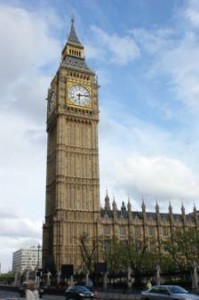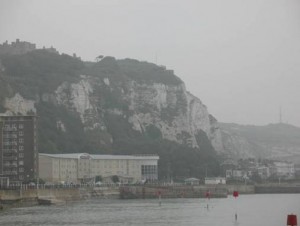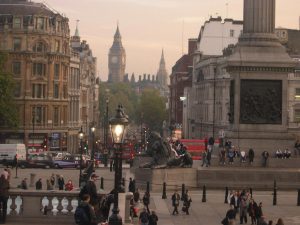Discovering Baptist History Tour
by Rick Shrader
Discovering Baptist History from Rick Shrader on Vimeo.
These are highlights of our Baptist History Trips to England and Scotland

You are browsing archives for
by Rick Shrader
Discovering Baptist History from Rick Shrader on Vimeo.
These are highlights of our Baptist History Trips to England and Scotland

by Rick Shrader
I still have a great interest in the United Kingdom, especially the Baptist history of England and Scotland. Edinburgh may have more bizarre and creepy stories of any older or ancient city—like the story of Margaret Dickson who was hanged for illicit behavior, only when they heard tapping on her casket and opened it, she was still alive—and lived for another 40 years (not being liable for the crime for which she already suffered a punishment) being called “Half Hangit Maggie Dickson.”

by Debra Conley

What else can I add to these two years of vicarious travel through the UK? Plenty! Traveling with us is definitely an adventure. If we see something curious, we might just take off to check it out. Most days we leave the hotel right after breakfast and do not return until evening. We do a lot of walking and Rick makes sure we find the fish & chips lunch whenever we can. For those of you who must have your American food, there’s Subway, McDonald’s, and Burger King everywhere.
Before we began making these regular trips, I delved into Rick’s recommended reading for the Seminary students. Nothing prepared me for what I would experience when I actually stood where great men of God like Spurgeon, Bunyan, Carey, and others preached and gave their lives to change the world. Knowing that I stood where martyrs were slain and remembering that Tyndale had been executed for his determination to see the Word survive, instilled a greater depth of reverence for this history than any book. The saddest realization, though, is to see how empty the great churches have become, with the notable exception of Metropolitan Baptist Temple pastored by Peter Masters.
Local dialect makes vocabulary part of the fun. “Straight way” has nothing to do with geometry or a Biblical walk. It means right now. Half eight doesn’t mean four; it means 8:30. The British also have a funny habit of spelling words with letters they never use, like Worcestershire (“Worster”) and Leicester (“Lester”), and Southwark (“Sutharc”). Tabloid headlines are often clever: “Brown in the Line of Ire” or “Farewell to Alms.”
A long ago practice that we might revive is the signing of the Settlement Document. This agreement, signed by all newcomers to a community, stated that if the newcomer became indigent and on the public dole, he agreed to go back where he came from. William Carey was required to sign such a document which is on display in the Carey Museum at Moulton.
Petrol, you say? This last trip it was 1.99 pounds ($4) per liter plus the 23% tax. But the trip is worth every penny. So Follow the leader (especially in the Tube); Enjoy the sights; Drink the tea!


by Debra Conley

What else can I add to these two years of vicarious travel through the UK? Plenty! Traveling with us is definitely an adventure. If we see something curious, we might just take off to check it out. Most days we leave the hotel right after breakfast and do not return until evening. We do a lot of walking and Rick makes sure we find the fish & chips lunch whenever we can. For those of you who must have your American food, there’s Subway, McDonald’s, and Burger King everywhere.
Before we began making these regular trips, I delved into Rick’s recommended reading for the Seminary students. Nothing prepared me for what I would experience when I actually stood where great men of God like Spurgeon, Bunyan, Carey, and others preached and gave their lives to change the world. Knowing that I stood where martyrs were slain and remembering that Tyndale had been executed for his determination to see the Word survive, instilled a greater depth of reverence for this history than any book. The saddest realization, though, is to see how empty the great churches have become, with the notable exception of Metropolitan Baptist Temple pastored by Peter Masters.
Local dialect makes vocabulary part of the fun. “Straight way” has nothing to do with geometry or a Biblical walk. It means right now. Half eight doesn’t mean four; it means 8:30. The British also have a funny habit of spelling words with letters they never use, like Worcestershire (“Worster”) and Leicester (“Lester”), and Southwark (“Sutharc”). Tabloid headlines are often clever: “Brown in the Line of Ire” or “Farewell to Alms.”
A long ago practice that we might revive is the signing of the Settlement Document. This agreement, signed by all newcomers to a community, stated that if the newcomer became indigent and on the public dole, he agreed to go back where he came from. William Carey was required to sign such a document which is on display in the Carey Museum at Moulton.
Petrol, you say? This last trip it was 1.99 pounds ($4) per liter plus the 23% tax. But the trip is worth every penny. So Follow the leader (especially in the Tube); Enjoy the sights; Drink the tea!


by Debra Conley

As we honor Veterans this month, it is most fitting that I write about our visit to Dover, England. This massive and beautiful coast has seen its share of war, battles, and still proudly, the huge fortress of Dover Castle regales atop the White Cliffs. It was this coast, only 22 miles from France, that the first real foreign threat accosted England. William the Conqueror, in 1066, crossed the Channel from Normandy and defeated King Harold at the Battle of Hastings. French and English monarchs were entwined with each other’s politics for centuries thereafter. The monstrous Dover Castle was begun by the Romans in the 1st Century and added to with each successive ruler. The war tunnels were originally built during the Napoleonic Wars to defend the southern coast and have been used by most every English sovereign.
It was from the White Cliffs at Dover that some of the most impressive WWII English victories were managed. The wartime tunnels are still as they were, the center for naval operations, radar detection, and the defense of Kent. A secure hospital is also located within the fortress. It was here that Admiral Ramsey directed the rescue of forces from Dunkirk. Later, the 1940 Battle of Britain was orchestrated from here with a new invention: radar. Winston Churchill, in honoring the RAF victory over the German Luftwaffe, said, “Never in the field of human conflict has so much been owed by so many to so few.”
Only 22 miles across from Dover are the Normandy Beaches, visible on a clear day from the castle hill. The world owes much to those who fought in Operation Overlord, which was a major turning point in the Allied Victory of WWII.
The Castle and War Tunnels are open for tours. From the train station at Dover Priory, take the bus marked to the castle, tunnels, or cliffs. It is too far a walk to the coast from the train station and still have time to view all there is to see. Boats transfer from the Portsmouth harbor to Normandy daily.
Wherever I go, if there is a notable body of water (Pacific Ocean, Black Sea, etc.), I try to take a swim or wade in it just to say I’ve been in it. The day Rick and I were in Dover, the water temperature felt like it was one degree above freezing and swimming in our heavy overcoats seemed a little ridiculous. So I reached my hand into the water and quickly shoved it back into my wool mittens. But I can say I’ve been in the English Channel!

by Debra Conley

As we honor Veterans this month, it is most fitting that I write about our visit to Dover, England. This massive and beautiful coast has seen its share of war, battles, and still proudly, the huge fortress of Dover Castle regales atop the White Cliffs. It was this coast, only 22 miles from France, that the first real foreign threat accosted England. William the Conqueror, in 1066, crossed the Channel from Normandy and defeated King Harold at the Battle of Hastings. French and English monarchs were entwined with each other’s politics for centuries thereafter. The monstrous Dover Castle was begun by the Romans in the 1st Century and added to with each successive ruler. The war tunnels were originally built during the Napoleonic Wars to defend the southern coast and have been used by most every English sovereign.
It was from the White Cliffs at Dover that some of the most impressive WWII English victories were managed. The wartime tunnels are still as they were, the center for naval operations, radar detection, and the defense of Kent. A secure hospital is also located within the fortress. It was here that Admiral Ramsey directed the rescue of forces from Dunkirk. Later, the 1940 Battle of Britain was orchestrated from here with a new invention: radar. Winston Churchill, in honoring the RAF victory over the German Luftwaffe, said, “Never in the field of human conflict has so much been owed by so many to so few.”
Only 22 miles across from Dover are the Normandy Beaches, visible on a clear day from the castle hill. The world owes much to those who fought in Operation Overlord, which was a major turning point in the Allied Victory of WWII.
The Castle and War Tunnels are open for tours. From the train station at Dover Priory, take the bus marked to the castle, tunnels, or cliffs. It is too far a walk to the coast from the train station and still have time to view all there is to see. Boats transfer from the Portsmouth harbor to Normandy daily.
Wherever I go, if there is a notable body of water (Pacific Ocean, Black Sea, etc.), I try to take a swim or wade in it just to say I’ve been in it. The day Rick and I were in Dover, the water temperature felt like it was one degree above freezing and swimming in our heavy overcoats seemed a little ridiculous. So I reached my hand into the water and quickly shoved it back into my wool mittens. But I can say I’ve been in the English Channel!

White Cliffs of Dover

by Debra Conley

Our tour gives each guest a little free time in London, and there are so many places to take in around London! Packed with so much history and certainly worth the price is the Tower of London. Specially trained guides called Beefeaters weave a thousand years of history into the 2 hour tour. You’ll see the Traitor’s Gate where prisoners entered the Tower from the Thames, the actual cells of Anne Boleyn and Sir Walter Raleigh, and the glow-in-the-dark crown jewels which are removed under guard for Coronations or State events. There is also a knight in armor demonstration and viewing of the execution sites.
Buckingham Palace is not the massive edifice most expect, but the pomp and ceremony of the Royal Guards is the attraction. Of course, if you happen to be at the front when the Queen is leaving, you get an extra bonus. Within a short walk of the Palace is Whitehall and 10 Downing Street where the Churchill War Rooms, built in huge concrete tunnels beneath the government buildings, are open for visitors. The War Rooms are preserved exactly as they were the day WWII ended.
For a cultural view of London, head for Carnaby Street, Covent Garden at the west end, or Picadilly Circus. “Picadils” are French ruffles; circus means round, and so this roundly built commercial area was originally for dressmakers (of ruffled shirts) and haberdashers. Covent Garden is an eclectic collection of boutiques, cafes, a few antique stores, and lots of colorful people. At Carnaby, you’ll find everything you threw out in the 1960’s.
Hyde Park and its Speakers’ Corner are just across from the Royal Albert Hall. There is a gallows site originally made for prisoner executions; each doomed soul was allowed to say anything he wanted before being hanged. Today, any person who can speak eloquently enough to gather attention is welcome to air his views. Some interesting conversations!

by Debra Conley
Our tour gives each guest a little free time in London, and there are so many places to take in around London! Packed with so much history and certainly worth the price is the Tower of London. Specially trained guides called Beefeaters weave a thousand years of history into the 2 hour tour. You’ll see the Traitor’s Gate where prisoners entered the Tower from the Thames, the actual cells of Anne Boleyn and Sir Walter Raleigh, and the glow-in-the-dark crown jewels which are removed under guard for Coronations or State events. There is also a knight in armor demonstration and viewing of the execution sites.
Buckingham Palace is not the massive edifice most expect, but the pomp and ceremony of the Royal Guards is the attraction. Of course, if you happen to be at the front when the Queen is leaving, you get an extra bonus. Within a short walk of the Palace is Whitehall and 10 Downing Street where the Churchill War Rooms, built in huge concrete tunnels beneath the government buildings, are open for visitors. The War Rooms are preserved exactly as they were the day WWII ended.
For a cultural view of London, head for Carnaby Street, Covent Garden at the west end, or Picadilly Circus. “Picadils” are French ruffles; circus means round, and so this roundly built commercial area was originally for dressmakers (of ruffled shirts) and haberdashers. Covent Garden is an eclectic collection of boutiques, cafes, a few antique stores, and lots of colorful people. At Carnaby, you’ll find everything you threw out in the 1960’s.
Hyde Park and its Speakers’ Corner are just across from the Royal Albert Hall. There is a gallows site originally made for prisoner executions; each doomed soul was allowed to say anything he wanted before being hanged. Today, any person who can speak eloquently enough to gather attention is welcome to air his views. Some interesting conversations!

Tower Bridge

Big Ben

by Debra Conley

An original Roman wall greets visitors to Canterbury as you arrive by train from London. To get to the famous Cathedral, the top of the wall serves as your footpath. The crest of the wall gives each pedestrian a good view of the Cathedral spires as well as the town below. Once in the town, it’s a four block walk to the entrance of Canterbury Cathedral, one of my favorites in England. Started in the 600’s by England’s first Archbishop, St. Augustine, the Cathedral’s massive beauty is breath taking and it is still the official seat of the Archbishop. Regular services include organ and choir recitals; CD’s of the recitals are available.
History of the Canterbury Cathedral always includes one of its darkest moments, that of the martyrdom of Archbishop Thomas Becket in 1170. The murder by knights of Henry II took place inside the Cathedral as Becket was preparing for Vespers, which made the act even more heinous. Geoffrey Chaucer’s famous Canterbury Tales are structured on the Pilgrimage from Southwark Cathedral in London to Canterbury to honor the slain Becket. Having taught this great literary work for many years, it was especially gratifying for me to have been to both the Southwark Cathedral beginning of the journey and then to the destination at Canterbury.
A series of Bible windows, done in exquisite stained glass, tell of the great saints, of Jesus and His miracles, and were installed for the benefit of the illiterate who were encouraged to sit where they could view the windows and learn visually. The great bell tower contains 14 bells, all of which still ring regularly.
As part of the tour of the Cathedral, the East and West Crypts on the lower level are extensive; visitors are asked to remain quiet and solemn while walking through the graves. Becket’s tomb was in the East Crypt, but later moved to the Cathedral’s larger main area to accommodate the number of visitors who want to see the tomb. Several exclusive private schools surround the Cathedral area and students from these schools provide concerts, dramas, and other contributions to the Canterbury experience. The town itself is another of the quaint English towns so often affixed in our tourist images. Street vendors offer wares next to smart shops nestled behind historic facades. Town folk gather on benches at the shade trees for daily conversation and life is leisurely.
Canterbury Cathedral

by Debra Conley

An original Roman wall greets visitors to Canterbury as you arrive by train from London. To get to the famous Cathedral, the top of the wall serves as your footpath. The crest of the wall gives each pedestrian a good view of the Cathedral spires as well as the town below. Once in the town, it’s a four block walk to the entrance of Canterbury Cathedral, one of my favorites in England. Started in the 600’s by England’s first Archbishop, St. Augustine, the Cathedral’s massive beauty is breath taking and it is still the official seat of the Archbishop. Regular services include organ and choir recitals; CD’s of the recitals are available.
History of the Canterbury Cathedral always includes one of its darkest moments, that of the martyrdom of Archbishop Thomas Becket in 1170. The murder by knights of Henry II took place inside the Cathedral as Becket was preparing for Vespers, which made the act even more heinous. Geoffrey Chaucer’s famous Canterbury Tales are structured on the Pilgrimage from Southwark Cathedral in London to Canterbury to honor the slain Becket. Having taught this great literary work for many years, it was especially gratifying for me to have been to both the Southwark Cathedral beginning of the journey and then to the destination at Canterbury.
A series of Bible windows, done in exquisite stained glass, tell of the great saints, of Jesus and His miracles, and were installed for the benefit of the illiterate who were encouraged to sit where they could view the windows and learn visually. The great bell tower contains 14 bells, all of which still ring regularly.
As part of the tour of the Cathedral, the East and West Crypts on the lower level are extensive; visitors are asked to remain quiet and solemn while walking through the graves. Becket’s tomb was in the East Crypt, but later moved to the Cathedral’s larger main area to accommodate the number of visitors who want to see the tomb. Several exclusive private schools surround the Cathedral area and students from these schools provide concerts, dramas, and other contributions to the Canterbury experience. The town itself is another of the quaint English towns so often affixed in our tourist images. Street vendors offer wares next to smart shops nestled behind historic facades. Town folk gather on benches at the shade trees for daily conversation and life is leisurely.

Canterbury Cathedral
